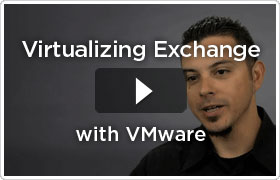
Exchange Virtualization
Virtualizing Microsoft Exchange on VMware vSphere
Run Microsoft Exchange on VMware vSphere to not only match, but exceed the performance of physical servers by 100% or more. Consolidate multiple Exchange server roles and mailboxes to reduce infrastructure footprint by 5X to 10X. Maximize Exchange availability without the complexity of Microsoft clustering. Right-size Exchange infrastructure and scale your mailboxes dynamically to support increasing loads.
Recommended Products
- VMware vSphere
- VMware vCenter Server Standard
- VMware vCenter Site Recovery
- VMware Fault Tolerance
Overview:
Double the Performance of Your Exchange Infrastructure

Microsoft Exchange 2007 and 2010 perform very well on VMware vSphere. Run all Exchange server roles, including the mailbox server, on vSphere with confidence, to not only match but exceed the performance of physical servers. Each VMware vSphere virtual machine scales to 32 vCPU and 1 TB of memory, and can easily support the IO intensive requirements of Exchange mailbox servers. With VMware vSphere, multiple mailboxes can be scaled out on larger multicore servers to increase overall throughput. For example, on a 16 core server, we have demonstrated that VMware vSphere can double the maximum throughput achieved with Exchange 2007 from 8,000 to 16,000 end-user mailboxes.
Consolidate Exchange Infrastructure by 5X to 10X
Exchange infrastructure can typically be consolidated by 5X to 10X with vSphere. Consolidate multiple Exchange server roles onto shared physical servers and eliminate the need to deploy dedicated standby hosts for high availability and disaster recovery.
Ensure Exchange Availability and Service Levels
Maximize Exchange availability without the complexity of Microsoft Clustering. Leverage the Application Services built into vSphere to provide simple and cost-effective high availability and disaster recovery for all Exchange server roles without needing dedicated standby servers. Alternatively, run Microsoft Clustering on VMware vSphere to double your protection and provide best-in-class availability.
Scale Exchange dynamically to support increasing loads, eliminate sizing headaches, and reduce overprovisioning. Start with small memory and CPU configurations and gradually expand capacity to support growing load by machinehot-adding capacity to virtual machines or migrating with VMware vMotion to larger hosts.
Accelerate delivery of new email services. Provision new Exchange instances or additional services such as BlackBerry Enterprise Server from pre-configured vApps in just minutes. Use VMware snapshots and clones to reproduce your Exchange environment in the lab for testing and troubleshooting, and eliminate the need to maintain a dedicated test environment.
Leverage Full Microsoft Support for VMware vSphere
Microsoft officially supports VMware vSphere for running Microsoft Windows and major applications including Microsoft Exchange, SQL Server, and SharePoint Server. VMware ESX was the first hypervisor to be validated under the Microsoft Virtualization Validation Program (SVVP), providing customers who run Windows Server and Microsoft applications with cooperative support from Microsoft and VMware. Customers can now run Exchange on vSphere with the peace of mind that they will receive the same level of support they received on physical servers.
Full Support for VMware vMotion, HA and DRS in virtualized Exchange environments. Organizations virtualizing Exchange can benefit from VMware's availability options with full support from Microsoft. VMware HA, DRS and vMotion features are fully supported with Exchange 2010 DAGs as of Exhange 2010 SP1. Read VMware's guidance on using vMotion, HA and DRS with Exchange 2010 DAG.
New Microsoft licensing enables efficient use of vMotion. Microsoft licensing has recently been modified to allow customers to reassign licenses between physical servers as frequently as desired. This new licensing flexibility enables efficient use of vMotion for Windows Server and major applications including Exchange, SQL Server, and SharePoint Server.
Performance:
Support the Largest Exchange Mailboxes
Leverage the latest advances in VMware vSphere and Exchange performance to run the largest mailbox server instances with confidence that performance will match or exceed physical performance.
The performance and scalability of VMware vSphere have improved dramatically over the latest product releases. vSphere is able to handle the most demanding workloads thanks to improvements such as:
- Virtual Machine scalability increased to 32 vCPU and 1TB of memory
- VMware vSphere Disk IO scalability increased to more than 1000,000 IOPS, enabling VMware ESX to support IO-intensive applications such as Exchange and large Databases
- VMware vSphere network IO increased to 36 Gbps
Today, a single VM with 32 vCPUs is larger than the largest Microsoft recommended Exchange 2010 configurations for single role on a server (12 cores or vCPUs) and multiple roles on a server (24 cores or vCPUs). At the same time, Microsoft Exchange 2010 and 2007 include architectural and performance improvements that significantly reduce the IO requirements as compared to Exchange 2003:
- Cache increased from 900MB to multi-GB
- 70% reduction in disk IO
- Read / write ratio reduced to 1:1
Together, these performance improvements ensure that even large, demanding mailbox servers perform well on vSphere with no IO bottlenecks or other performance problems. As demonstrated in our labs, Exchange can be scaled out very efficiently on vSphere and can be scaled up to support large mailboxes.
Double Performance of Exchange Infrastructure
Increase the performance of your physical infrastructure by 100% or more. For example, without VMware, a single Exchange 2-7 mailbox running on a physical server can scale up to about 8,000 heavy user mailboxes. Using larger servers doesn't help because the mailbox can't leverage the additional capacity.
With VMware, Exchange mailboxes can be scaled out on multiple smaller virtual machines to maximize the throughput of the physical server. Using this approach, we have demonstrated that Exchange can be scaled out on 8 Virtual Machines, each supporting 2,000 very heavy mailbox users, to support 16,000 users on one 16-core server.
Private Cloud:
Ensure Availability without the Complexity of Microsoft Clustering

- Provide simple and cost-effective high availability and disaster recovery for all Exchange server roles with VMware Fault Tolerance, VMware High Availability, vMotion, and Site Recovery Manager. Eliminate the need to deploy complex Microsoft Clustering solutions and dedicated standby servers. Alternatively, run Microsoft Clustering on vSphere and combine with vSphere availability solutions to achieve best-in-class availability. Eliminate planned downtime for hardware maintenance with VMware vMotion. Simply vMotion your Exchange virtual machines to another physical host for the duration of the maintenance, with no impact on service availability.
- Protect all Exchange server roles against hardware failures and OS problems with VMware Fault Tolerance or VMware High Availability. In the event of hardware failure, VMware FT ensures continuous availability with no data loss, while VMware HA automatically restarts the virtual machines on another host in minutes.
- Implement a simple, automated disaster recovery plan with VMware disaster recovery solutions and Site Recovery Manager. Replicate and recover virtual machines on a secondary site, including entire Exchange deployments, without dedicated standby hardware.
- For continuous application-aware availability, combine Microsoft Clustering with VMware availability solutions to provide an additional layer of protection and maximize uptime.
Scale Exchange Dynamically to Ensure Service Levels
Sizing Exchange infrastructure leads to a difficult compromise between providing enough capacity to support future requirements while keeping infrastructure costs under control. Use vSphere to "right-size" virtual machines for today's needs with the ability to scale dynamically to support future loads.
- Start with small memory and CPU configurations
- Use vCenter CapacityIQ to right-size infrastructure for today's needs
- If a host runs out of capacity, VMware DRS automatically triggers vMotion to move the Exchange virtual machines to another host with appropriate resources
- If an Exchange mailbox runs out of capacity, hot-add CPU, memory or disk to preserve service-levels
Accelerate Delivery of New Email Services
Provisioning new email services into production can take months of lead time to procure and install dedicated hardware, provision and configure the OS, and finally configure the application. This long manual process is also error-prone and can lead to configuration mistakes and service downtime.
With vSphere, create a library of vApps that can be provisioned on demand onto your existing virtual infrastructure in minutes. For example, with virtual appliances, reduce the lead time to deploy BlackBerry Enterprise Server from weeks or months down to minutes.
Test and troubleshoot your complex email applications quickly while minimizing risk of change. Use vCenter Snapshots and Clones to reproduce your vApps, encapsulating entire multitier applications, in the lab in minutes. Test your application changes in the context of related application tiers, and on an exact copy of your production configuration, to minimize the risk of errors. Eliminate the need to provision applications manually for each test cycle.
Microsoft Support:
Microsoft officially supports Windows Server and Server products running on VMware ESX. This includes Windows Server 2000 SP4, Windows Server 2003 SP2 or later, and Windows Server 2008 and specialty roles provided by the operating system such as Active Directory or File Services. Major applications that are supported include Microsoft Exchange, SQL Server, and SharePoint Server. Microsoft has published a complete list of supported applications, and continues to update it. Supported ESX configurations are also listed.
VMware ESX was the first hypervisor to be validated under the Microsoft Virtualization Validation Program (SVVP), providing customers who run Windows Server and Microsoft applications with cooperative support from Microsoft and VMware. Customers can now run Exchange on VMware with the peace of mind that they will receive the support they need.
Microsoft Adopts vMotion-Friendly Licensing
Microsoft licensing has recently been modified to allow customers to reassign licenses between physical servers as frequently as desired. In the past, licenses could only be reassigned once every 90 days, limiting the benefits of vMotion. The new licensing flexibility enables efficient use of vMotion for Windows Server and major applications including Exchange, SQL Server, and SharePoint Server.
Non SVVP-Validated Configurations
What happens if you are running a non SVVP-validated configuration of ESX and Microsoft products? Customers routinely tell us they still receive the Microsoft support benefits. Support options vary, however, depending on how customers purchase VMware and Microsoft products.
The following scenarios are common:
Scenario 1: VMware software was originally purchased through a server OEM
Server resellers including Dell, Fujitsu, Fujitsu-Siemens, HP, IBM, and Unisys offer end-to-end support for Microsoft software running on their servers and VMware if VMware products are purchased with the server hardware and are covered by a valid support agreement with the server reseller. This provides customers one-stop support via the server reseller if an issue arises.
Scenario 2: VMware software was originally purchased direct from VMware or a VMware authorised reseller and the customer has a valid Microsoft Premier-level support agreement
Microsoft states that it will use "commercially reasonable efforts" to support its products running on VMware virtual machines. Customers regularly tell us that Microsoft's commercially reasonable efforts are effective and appropriate to maintain operations as planned. There may be confusion within Microsoft's field and channel organizations regarding the scope of support that can be provided, and in some cases, customers may perceive that "commercially reasonable efforts" will not meet their expectations. In general, Microsoft offers its large customers excellent support for their products running on VMware. Microsoft's policy states that after such efforts are exhausted, Microsoft support specialists may request that customers replicate the issue on a physical machine in order to proceed with the investigation.
Scenario 3: VMware software was originally purchased direct from VMware or a VMware authorised reseller and the customer does not have a Microsoft Premier-level support agreement
Microsoft's level of support for these customers can be more restrictive. Before providing support, Microsoft specialists may request that customers first replicate the issue on a physical machine per Microsoft KB 897615.

